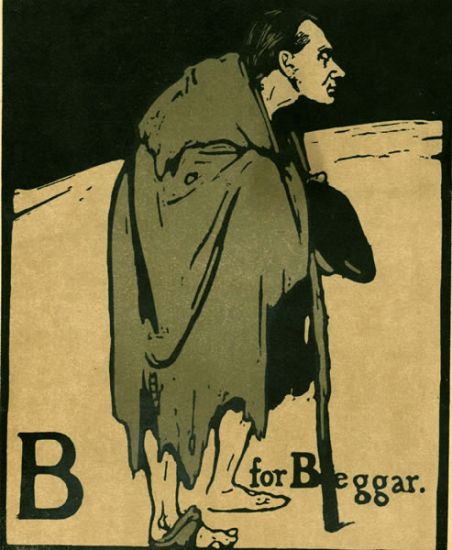
B for Beggar, circa 1898 (Portrait of James Pryde)
Unmounted (ref: 2621)
Chromolithographs after the original woodcuts
Each, 9 7/8 x 7 7/8 in. (25 x 20 cm.)

Chromolithographs after the original woodcuts
Each, 9 7/8 x 7 7/8 in. (25 x 20 cm.)
From the popular edition, circa 1898
Three editions of Nicholson's celebrated Alphabet were published in
October 1897 - a De luxe edition (of around 50) printed directly from
the woodblocks and coloured by hand; a Library edition of lithographic
reproductions printed on laid paper; a popular edition of lithographic
reproductions printed on cartrigde paper. The first impression of
the Popular edition was out of print by 1 January 1898.
William Nicholson was born in 1872, the same year as Aubrey Beardsley.
Though completely different in style and technique, each revolutionized
the course of graphic art in the nineties.
Nicholson and his brother-in-law, James Pryde-as the Beggarstaff
Brothers-developed a new form of poster art which combined masses of
three or four colors around a central silhouette. These vigorous forms
are in marked contrast to the tedious line work, which was then
characteristic of the Victorian period.
Through a recommendation by James McNeill Whistler, Nicholson began to
illustrate for the publisher William Heinemann. Between 1897 and 1900
he illustrated five works: An Alphabet, An Almanac of Twelve Sports,
Twelve Portraits, London Types, and The Square Book of Animals. In
addition, he designed Heinemann's enduring windmill colophon.
An Alphabet, the first book to appear, contains 26 portraits. A
self-portrait appears as the first plate, followed by a portrait of
James Pryde. Nicholson cut the illustrations himself on woodblocks. A
small part of the edition was printed from the actual woodblocks, which
he then colored by hand. Most of the edition consists of color
lithographs after the woodcuts.
In An Alphabet and the subsequent works, Nicholson has refined the
original Beggarstaff concept. The backgrounds are now composed of earth
tones and black. In contrast to these muted masses is a most
purposefully restrained use of color. While other artists of the Art
Nouveau period were producing veritable color charts, Nicholson
demonstrated that less is more.
William Nicholson made his impact on the development of graphic art in
the twentieth century before his thirtieth birthday. Later he turned to
painting and stage design. He was knighted in 1936 and died in 1949.
His eldest son is the artist Ben Nicholson.